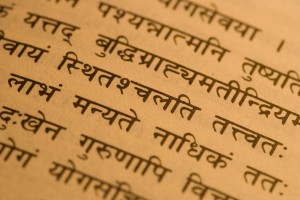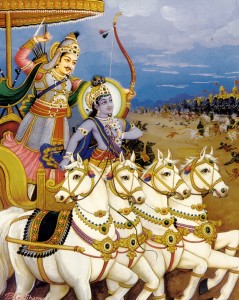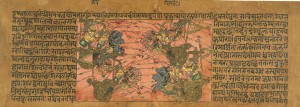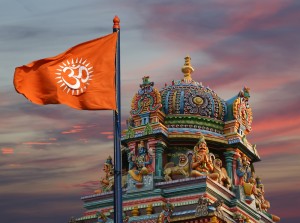Bhagvad Gita is one of the most sacred, if not the most sacred of Hindu texts. It has gained cult status, with people from different walks of life, from religious to completely non-religious background emphatically thumbing their support for it. Even the common man is sensitised to its sacredness, what with the oath of honesty one has to take while in matters of courts and law. In that way, it is to Hindus what Koran is to Muslims or Bible is to Christians.
Yet, Gita is not a standalone work or complete in itself, like say the Koran and Bible are. It is a part of an overall epic of Mahabharata. In fact were we to make a size based comparison, it is very small part of the epic, having some 700 verses in a family of some 200000 verses. Nevertheless, Mahabharata is not sacred, but Gita is. I well remember in the past, there was a pervasive notion that if there is a  Mahabharata copy in your, there will fights and clashes in the family. Result, not many would keep the Mahabharata copy at home. But Ramayana, and more importantly Gita always find a place of honour in any Hindu god-fearing home.
Mahabharata copy in your, there will fights and clashes in the family. Result, not many would keep the Mahabharata copy at home. But Ramayana, and more importantly Gita always find a place of honour in any Hindu god-fearing home.
Recently, while discussing Mahabharata at the Comparative Mythology class, there was this bit about how Hindu epics like Mahabharata and Ramayana had numerous editions of interpretations. Through the ages, these stories have been told and retold, with a little tweak and a little addendum, for instance, Ram in a version of Bengali Ramayana is portrayed as a weakling, while Sita is the strong character (not surprising since in Bengal, woman have been always at the centre of things be it literature Labonya in Gora, films – Charulata (Satyajit Ray), or even in politics like Mamta). Similarly, in a tribal version of Ramayana from Madhya Pradesh, the second brother Lakshman takes a much bigger role, and is central to the theme. Meanwhile, in places like Thailand and Surinam, Hanuman is much more than a devout monkey-follower of Ram. Thus, in every retelling of a tale, there is some embellishment of it.
Mahabharata too has undergone many such interpretations, the story being told from varying perspectives, be it Karna, or Duryodhan (or should one say Suyodhan). There is even one work from the perspective of Karan’s wife. The sheer depth and character of the epic, lends itself to such works.
Gita somehow seems to have escaped from the cycle of interpretations. I mean there is much work and analysis on Gita, but there is not much interpretation. As the lecturer said in the mythology class, storyteller and mythologists always keep a healthy distance from Gita. It makes you scratch your head, as to what could be the reason for it?
 One of the explanations is to look at the nature of the content of Gita. Unlike the interesting milieu of the Mahabharata, Gita is a fairly staid. Essentially, the whole of Gita is actually an elongated sermon, given by Krsna to a confused Arjun, who is sort of dithering before the great war. Right through the 18 chapters Krsna more or less sums up the Hindu philosophy of birth, death and living. While answering to doubts raised by Arjun, Krsna lays the philosophy of divinity namely that of Advaita (non duality) and merges the concept of karma, addressing Arjun (and thereby all of us), to surrender on to him and think not the consequences of action. The chapters are an assimilation of the three schools of thoughts in Hinduism, what are dubbed to be the paths leading to god, namely, karma, gyana, and bhakti.
One of the explanations is to look at the nature of the content of Gita. Unlike the interesting milieu of the Mahabharata, Gita is a fairly staid. Essentially, the whole of Gita is actually an elongated sermon, given by Krsna to a confused Arjun, who is sort of dithering before the great war. Right through the 18 chapters Krsna more or less sums up the Hindu philosophy of birth, death and living. While answering to doubts raised by Arjun, Krsna lays the philosophy of divinity namely that of Advaita (non duality) and merges the concept of karma, addressing Arjun (and thereby all of us), to surrender on to him and think not the consequences of action. The chapters are an assimilation of the three schools of thoughts in Hinduism, what are dubbed to be the paths leading to god, namely, karma, gyana, and bhakti.
In fact, there is this theory that Gita is not even the same authorship as that of Mahabharata. It is contested that Vyasa never actually penned the Gita. Some scholars who have contended that going by the literary style, Gita, just before the Great War seems to be a bit out of place.
Look at it yourself, we are all set for a rousing climax, loads and loads action, drama and emotions. After all the intrigues and alliances, the dice is loaded and we are all going for a tumultuous ride. But just before even the first arrow is shot, you sort of hit a speed breaker, things are slowed, a lengthy lyrical detour is taken wherein we discover the core essence of Hindu philosophy. Krsna who’s divinity was sort of underplayed in the narrative, is suddenly presented in full glory as an all-encompassing god, you know like the aham Brahmasi (I am the universe) type.
This sudden shift of gears is a reason why many contend that Gita (in its current  avatar) is work that was added later. But why could that be? Why would someone add an extended philosophical narrative, later on?
avatar) is work that was added later. But why could that be? Why would someone add an extended philosophical narrative, later on?
This is where; I have a small hypothesis to make. But before that let me clear some air with a disclaimer: I am no scholar on Gita or any epics and whatever contentions I am making are done on the basis of my limited understanding or knowledge.
And that is what Gita according to me is, just like the statements above, a disclaimer of sorts. Confused? Let me explain.
Have you noticed, that before every action or important contention, there is always a disclaimer that precedes it. The purpose of the disclaimer is dual, to get your attention and makes things serious. Second, if the following matter is deemed to be contentious to save one from the implications. Just like my disclaimer attempted to do.
I believe to understand the raison d’être of Gita, one just to analyse all the events that unfold after Krsna convinces Arjun to pick up the Gandeeva again and start the familial annihilation.
Prior to the war, the Pandavas are all epitome of goodness, just, fair and very righteous. In fact the battle of Kurukshetra is almost forced upon them and they are sort of the reluctant and repentant participants. I mean take instance of Lakshagraha, when the palace of lacquer was especially constructed and subsequently burnt by Duryodhan, with the sole intention of wiping off the Pandavas. Even after it, they are ready to forgive the perpetrators, yearning for peace and happily resettle themselves at Indraprastha.
 Yet, once the war starts the same Pandavas are quite a changed lot. The righteous Pandavas suddenly display a zeal that could not be fathomed before. Before the war starts, the Pandavas did everything to stall it. But when it does, they are a completely different lot, guided by Krsna, there is no rule in the book that they do not bend in their pursuit of victory. They slayed Bhisma through trickery, killed Drona by a subterfuge, Karna by deceit, Jayadrata by a con, Duryodhan by an illegal act. And the standard justification for all has been the foul murder of Abhimanyu by the Kauravas. But the fact is, it is the Pandavas who started to break the “laws of righteousness” on the 10th day, when Bhisma was felled by Arjuna even when he had thrown away his arms on facing Shikandi. Abhimanyu’s death comes later, on the 13th day of the Great War. So, if at all the blame for breaking the law lies solely with the Pandavas, there were the ones who shot the first treacherous arrow.
Yet, once the war starts the same Pandavas are quite a changed lot. The righteous Pandavas suddenly display a zeal that could not be fathomed before. Before the war starts, the Pandavas did everything to stall it. But when it does, they are a completely different lot, guided by Krsna, there is no rule in the book that they do not bend in their pursuit of victory. They slayed Bhisma through trickery, killed Drona by a subterfuge, Karna by deceit, Jayadrata by a con, Duryodhan by an illegal act. And the standard justification for all has been the foul murder of Abhimanyu by the Kauravas. But the fact is, it is the Pandavas who started to break the “laws of righteousness” on the 10th day, when Bhisma was felled by Arjuna even when he had thrown away his arms on facing Shikandi. Abhimanyu’s death comes later, on the 13th day of the Great War. So, if at all the blame for breaking the law lies solely with the Pandavas, there were the ones who shot the first treacherous arrow.
Thus when the war begins, in a sudden volte-face, the righteous Pandavas are no more righteous anymore. And they are led down this path by none other than Krsna.
When we look at Gita now from that hindsight, it sort of justifies the actions of the Pandavas. There are numerous times, when Krsna emphasises that in pursuit of Dharma, any action is justified. He even nominates himself as the arbitrator of good and bad, and tells Arjun to merely pursue his duty. “Without being attached to the fruits of activities, one should act as a matter of duty, for by working without attachment one attains the Supreme.”
Hence, the Gita sort of sets the stage, it kind of gives the justification for what’s going to happen. In that sense, it is a rather long philosophical treatise that kind of absolves the Pandavas for all the ills of their action, namely they were following the Dharma.
I have a feeling that in the olden times, the narrators of Mahabharata must have been asked similar set of questions, as to why did Pandavas not follow the rules, and indulge in every wanton act of deceit and treachery. They must have used Gita as the justification; reminding of all the things Krsna said. And since, it was in Gita that it was revealed that he was the supreme lord. Thus, no one could judge him or his actions.
And so, Gita could possibly be an addendum that had to be added just so that people  are not mistaken about Dharma and its means. So, while in the Mahabharata, it is the ends that justify the means. In Gita, we are reminded that is not really so, and one must follow the right path. There is a sort of duality there and it could be a possible reason why Gita is there right before the battle in all its glory.
are not mistaken about Dharma and its means. So, while in the Mahabharata, it is the ends that justify the means. In Gita, we are reminded that is not really so, and one must follow the right path. There is a sort of duality there and it could be a possible reason why Gita is there right before the battle in all its glory.
To understand the purpose of Gita, one needs to keenly examine not only the content within it, but also whatever that followed the narration. And when, we look at it that way, it does seem like an asterisk mark, which states boldly, *Conditions Apply.
